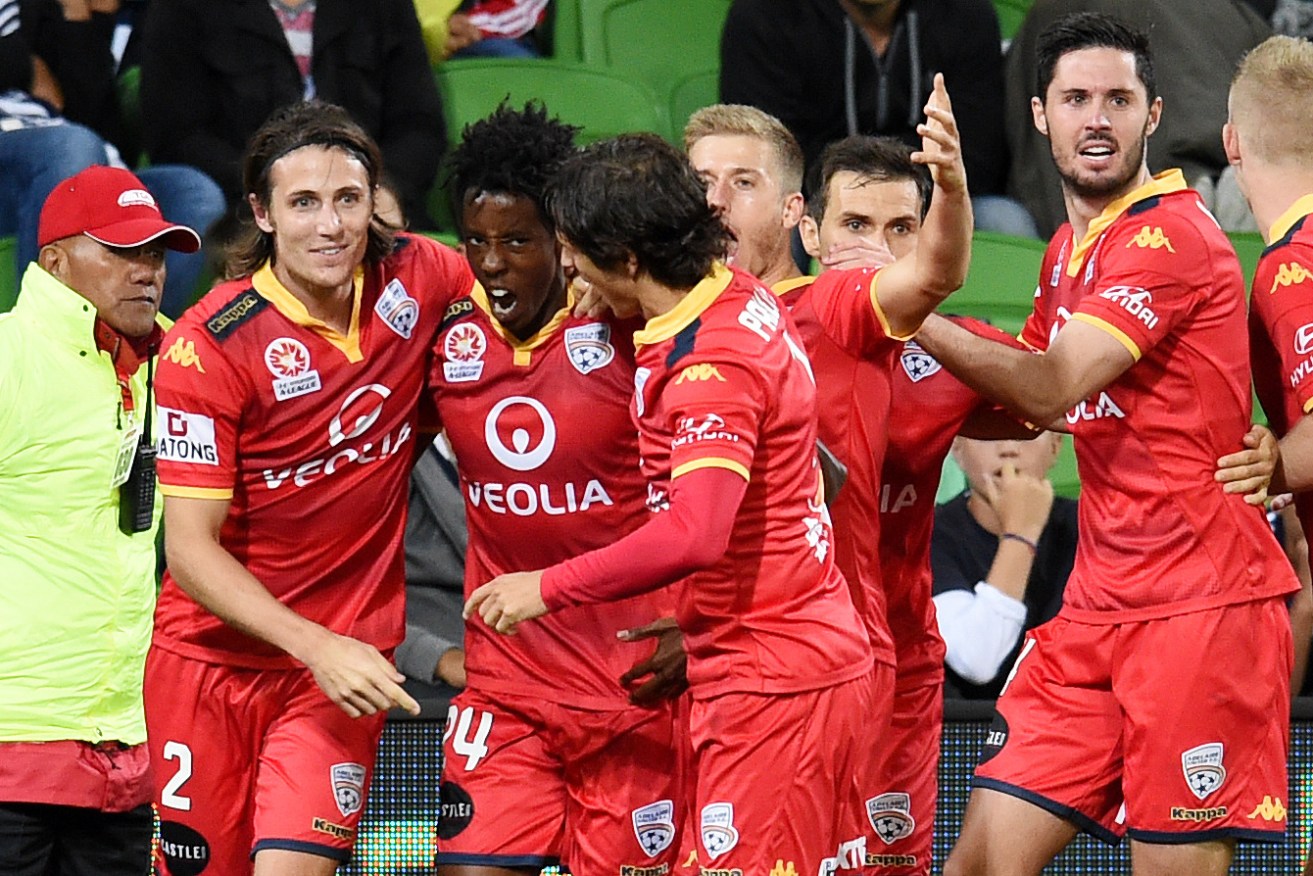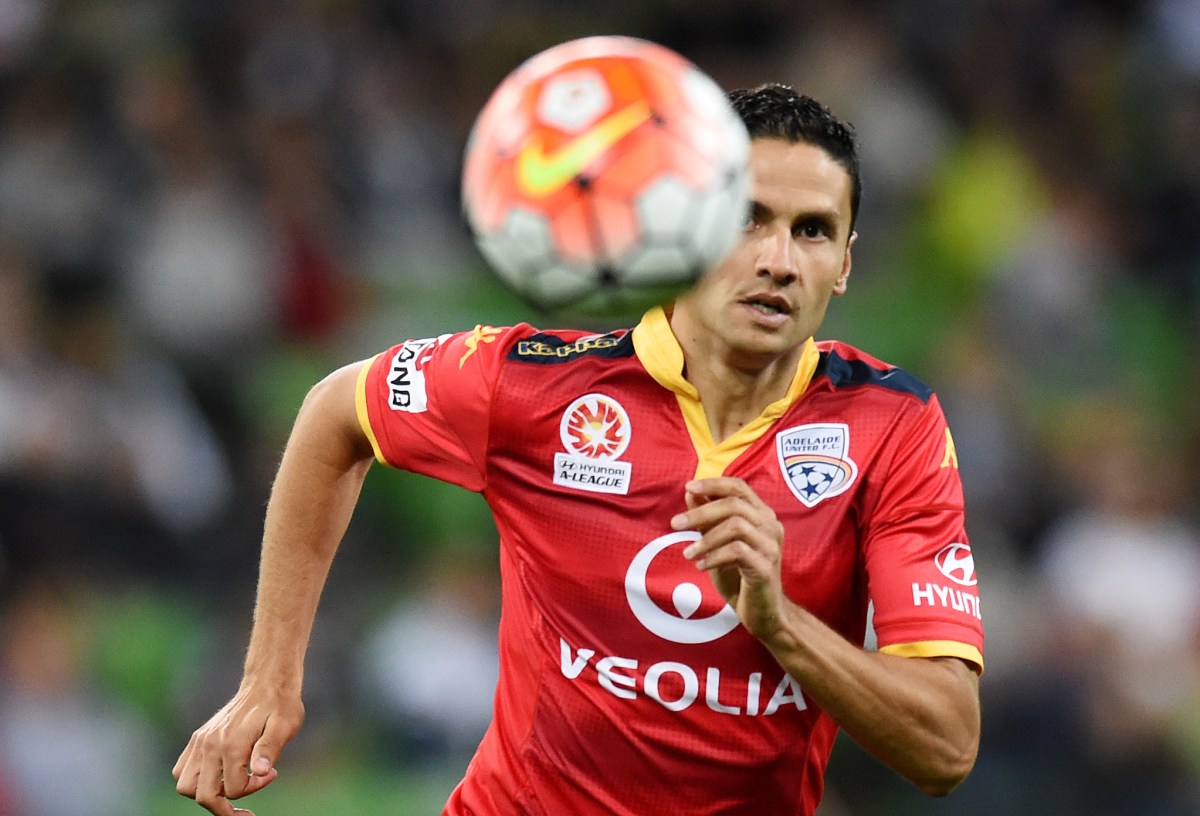United against history
At last, Adelaide has managed to ward off the inevitability of losing to the Victory in Melbourne. But, says Paul Marcuccitti, their quest for a championship still has a formidable precedent to overcome.

Bruce Kamau celebrates the winning goal that put Victory to the sword. Photo: Tracey Nearmy, AAP.
Death, taxes and Adelaide United losing to Melbourne Victory.
Particularly in Melbourne where, before Friday night’s triumph, LLLLL was the simplest way to describe the Reds’ last five away games in the A-League against their great rivals.
And, as we’re routinely reminded, United’s last win against Victory in Melbourne was more than five years ago. But that famous 4-1 mauling was also a drought breaker – it ended a run of ten matches (home and away) which… LLLLLLLLLL.
There are, however, other statistics that say much more about the Reds’ transformation this season.
This United team does its best work in the last 30 minutes of a game. While the Reds have netted 30 goals and conceded 25 this season, in the final half hour in all matches, it’s 17 for and 9 against. Since Round 8, when the club was bottom of the table and winless, its record after the first 60 minutes of its games is an impressive 12 for and 3 against.
One of three main shortcomings I kept mentioning last season and in the opening months of this campaign was the Reds were more likely to lose matches late in the game than they were to win them. That problem has certainly been solved.
It’s not impossible to win silverware without the kind of forward you can rely on to score every two or three games – but history is against it
It may be fitness, mental toughness, attitude, tactical flexibility or a combination of some or all of those things. Either way, strength in the dying minutes is a hallmark of successful teams.
Another criticism was the Reds kept the ball for most of their games but failed to create chances and then lost – the possession obsession. It reached its nadir in Round 3 against Perth when United had 70 per cent of play, made 669 passes to 286, and was defeated 3-1.
It looks like that silliness has ended too. In the excellent 4-1 win in Brisbane a month ago, United held possession for just 34.6 per cent of the game and made 326 passes to the home side’s 622. On Friday night, the Reds had the ball for 42.8 per cent of the match and passes favoured Victory 460-352.
Of course, having the ball isn’t a bad thing but too many observers overrate the relevance of possession.
How about some more focus on what you do when you don’t have the ball?
In those away wins against Brisbane Roar and Melbourne Victory, United won more duels and made more interceptions.
We should perhaps highlight those stats more often because what the Reds did without the ball was crucial to Friday night’s win; their pressure made it difficult for Victory to create many genuine chances.
And the only goal of the game was made possible by United’s Stefan Mauk coolly winning the ball from an opponent in midfield. Then, in an instant, Craig Goodwin, Mate Dugandzic, Pablo Sanchez and eventual scorer Bruce Kamau stormed forward with Mauk. That was important too – Victory’s defence was outnumbered.
Indeed both Dugandzic and Kamau were free. And although Kamau’s shot was deflected, there was nothing fortunate about the way the chance was created.
(With that happening in the 90th minute, it also underlined the team’s improvement in the closing stages of games.)
It’s normally United on the ball with Victory applying pressure.
Think back, for instance, to the teams’ pulsating 2-2 draw at Hindmarsh 11 months ago. The Reds held much more possession but it was the visitors winning the most duels (62.3 per cent of them) and making more interceptions. Victory also found a late equaliser just minutes after going behind. That’s what champion teams do and they would be crowned at the end of the season.
It’s worth noting that in that draw last season, Victory’s midfield included Mark Milligan and Carl Valeri. Both players do fantastic work when opponents have the ball.
Valeri, sadly, has been ruled out for the rest of the season to help him recover from an inflammatory condition affecting part of his brain; Milligan is now playing for a club in United Arab Emirates. You can’t easily replace players of that calibre and that’s one of the reasons why Melbourne Victory has come back to the pack.
I did mention three shortcomings that United had and the third remains: lacking a player that scores frequently.
Despite the Reds’ sensational run of results in the last 12 rounds, the club’s leading scorer for the season, Marcelo Carrusca, has just 5 goals.
There are 15 players with more A-League goals in 2015/16 and every other club has at least one of them.
It’s not impossible to win silverware without the kind of forward you can rely on to score every two or three games but history is against it.
Since the A-League expanded to 10 teams for 2009-10, only two sides have had any success without a player reaching double figures for the season.
Sydney FC did the Premiership and Championship double in 2009-10 with John Aloisi and Mark Bridge each scoring 9 times while Alex Brosque and Steve Corica each added 7.
In 2011-12, Central Coast ended the season with three players on 7 goals: Bernie Ibini-Isei, Patrick Zwaanswijk and Matt Simon (who was transferred to a Korean club after Round 14). The Mariners won the Premiership but then failed to reach the grand final.
Does an Adelaide player need to step up and finish the season with a flurry of goals? Or can the Reds keep their run going by sharing them around?
If they continue to find ways to win irrespective of whether they’re dominating, on the back foot, holding possession or playing without the ball, perhaps the latter is a real possibility.
Paul Marcuccitti’s soccer column is published in InDaily on Mondays. He is a co-presenter of 5RTI’s Soccer on 531 program which can be heard from 10am on Saturdays.





